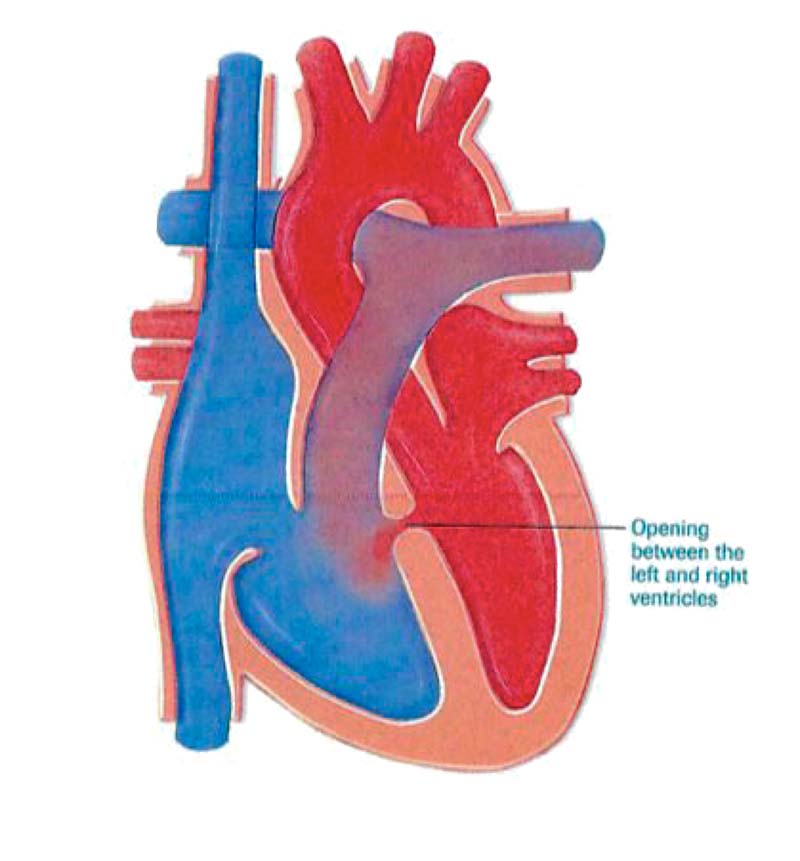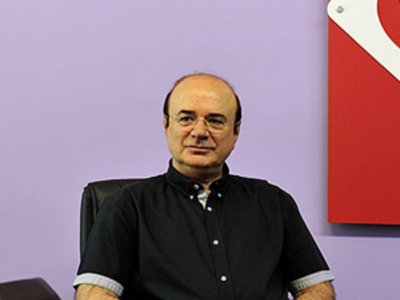By: Prof. Dr. Seyed Saeid Zamanieh Shahri, MD and Prof. Dr. Sonia Sayyedalhosseini, MD
Interventricular septal defect (VSD):
A ventricular septal defect is a hole or duct that forms in the dividing wall of the two chambers of the heart. In normal human growth and development, this hole in interventricular wall, closes after birth so that hypoxic blood does not combine with oxygenated blood after birth. Failure to close the hole can increase the pressure inside the heart or decrease the body’s oxygen supply. An interventricular wall defect is a defect in the septum between the left and right ventricles. The septum is a wall that separates the right and left areas of the heart. Sometimes wall defects are also called heart holes. This disorder is the most common congenital heart defect in newborns. Interventricular septal defect is less common in older children and adults because the hole will close on its own.
Causes of ventricular septal defect: The cause of this defect is unknown in most people, but genetic factors can play a role. VSD is a very common type of heart defect. Some people have other heart defects such as ASD (Atrial Septal Defect) in addition to ventricular septal defects.
The effect of VSD on the heart: Normally, the left side of the heart pumps blood only to the organs of the body and the right part of the heart pumps blood only to the lungs. When there is a large duct between the ventricles, a large amount of oxygen-rich blood is drawn from the left side of the heart through the duct to the right. Although this blood contains enough oxygen, it is pumped back to the lungs. Unfortunately, this phenomenon causes the heart to pump more blood. The heart, especially the left ventricle and atrium, begins to grow as a result of this extra work. Blood pressure in the blood vessels of the lungs may rise due to an increase in the amount of blood in the blood vessels. Over time, increased pulmonary blood pressure can cause permanent damage to the walls of blood vessels. When the defect is minor, not much blood enters through the duct from left to right, and its effects on the heart and lungs are minor.
Symptoms of ventricular septal defect in children and adults: A large VSD in childhood can cause respiratory problems. Most of these children undergo surgery to close such a defect. For this reason, the presence of large defect in the heart of children is not common, but if it exists, it can cause shortness of breath. Most adults have small VSD that do not cause symptoms. This is because the heart and lungs do not need to work harder. Small defect can produce a loud murmur (an abnormal heart sound) during a physical examination. Even small defects can sometimes lead to infections called endocarditis.
The size of the VSD: Many children with ventricular septal defect do not need surgery or other treatments, and many of these defects close on their own. Adults who used to have a hole in their heart and now that hole is closed, no murmur sound is heard and their ECG is also normal. If an echocardiogram is performed, an external sac called a ventricular wall aneurysm may be seen in the area where the interventricular defect closes. If the aneurysm is not found as an expected finding after the interventricular canal closes, this condition may lead to unnecessary tests and concerns.
Closure of the ventricular septal defect: If the defect is large in childhood, the person may have undergone open heart surgery. Complete closure of the ventricular septal defect is usually done by suturing a patch (a layer made of a special material) or part of the pericardium to this defect. The pericardium is a natural covering layer around the outer region of the heart. Eventually, the natural tissue covering the heart grows to cover the patch, which becomes a permanent part of the heart. Some of these holes can be sutured and closed without the use of a patch. Today, some of these types of holes can be closed in a catheter laboratory with a special device. This device can close the whole inlet. Also, some adults and young people may have undergone this process. Patients who repair their heart wall defects and their pulmonary artery blood pressure is normal, will also have a normal life expectancy. Problems after repair of this defect are not common, but a small number of patients may develop problems with the heart valves (aorta or triceps) or the size of the right heart muscle. All people who have had surgery to repair a defect in their ventricular wall should see a cardiologist regularly for regular checkups. This cardiologist should have experience with congenital heart defects in adults. Medication is rarely needed in these patients. Patients with large and unrepaired interventricular septal defects may develop pulmonary hypertension.
Complications of ventricular septal defect: Patients with small ventricular septal defects are at risk for a heart infection called endocarditis. Aortic valve leakage may occur and should be monitored. Patients whose ventricular septal defects are repaired early in life are less likely to have significant long-term problems. The risk of infection (endocarditis) is minimized if the ventricular septal defect is completely closed without blood leaking from the patch site. It is rare for a person to have irregular heartbeats. In some people, the ability of the heart muscle to contract may decrease after repair of an interventricular septal defect. In case of heart failure due to heart muscle weakness, the patient is given medications to control fluid accumulation, help the heart pump better, and control blood pressure. Patients with abnormal ventricular septal defects and high pulmonary hypertension may require medical treatment.
Activity Restrictions: Many patients do not need to limit their activities. However, if a person has high pulmonary hypertension or heart is not pumping well in the past, should limit activity level to the level of power. If you need to limit your activities, your cardiologist will help you do that.
Prevention of endocarditis: According to the latest recommendations of the American Heart Association, unrepaired interventricular septal defects do not require prevention of endocarditis. After successful closure of the ventricular septal defect, prophylactic treatments are only needed for a 6-month recovery period.
Pregnancy: If the defect in the closed ventricular wall is closed and the pulmonary blood pressure is completely eliminated, the chances of developing pregnancy problems will be low. It is important to see a cardiologist if the interventricular defect remains open. If a person does not have high pulmonary hypertension, she can tolerate pregnancy well. However, before deciding to become pregnant, one must be fully aware of the dangers posed by mother and child to prevent fetal interventricular wall defects.















